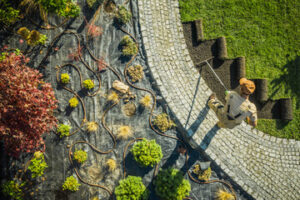A well-designed landscape is aesthetically pleasing and can support a variety of activities. It will also require minimal maintenance.

Costs vary based on project size and complexity. The choice of materials and labor rates are also important factors in pricing. Contact Prime Cut Lawn and Landscaping for professional help.
It is helpful to buy in phases when possible to reduce costs. This allows you to take your time and avoid making costly mistakes.
Plants play a vital role in landscape design, providing aesthetic appeal, promoting sustainability, and enhancing sensory experiences. When incorporated in thoughtful ways, plants shape outdoor spaces in ways that are both beautiful and functional, contributing to a healthy environment for people and wildlife alike.
Plant textures, forms, sizes and colors are what give each landscape its character. A landscape designer will use these characteristics to create a sense of balance and harmony within the composition, creating an overall cohesive look. In addition, the physical qualities of each plant and tree are used to complement and contrast with the hardscape features such as paths, patios and decks. By incorporating a mixture of plant personalities into the landscape, it’s possible to achieve a variety of visual effects that grab the viewer’s attention.
A common theme found in many residential landscaping projects is the use of native species. This is because native plants have co-evolved with the local ecosystem, forming an integral part of it. By contrast, exotic or “alien” plants are imported from other areas, severing the food web and degrading habitat in natural areas. Native plants are also easier to maintain because they adapt naturally to the area, reducing the need for chemical fertilizers and pesticides.
When choosing plants, it is important to take into account their mature height and size as well as the amount of sun or shade they will receive. These factors are crucial in ensuring the health and longevity of your landscaping, as well as preventing future costly repairs. In addition, it is essential to consider the effect your landscaping will have on the surrounding environment. For example, the right placement of trees can reduce energy costs by shading a home in summer and blocking freezing winds in winter.
Another benefit of proper landscaping is its ability to enhance the appearance of a property and increase its value. Landscaping can be done in a variety of ways, such as adding a pond or water feature, installing lighting and paving materials like stone or pavers. It can also include trees and shrubs, which help to reduce noise pollution, improve air quality, provide privacy and promote a sense of well-being.
Rocks
Rocks are an integral part of any landscape project, providing a variety of benefits such as weed control and improved drainage. They also add texture and visual interest, creating an inviting ambiance that enhances the beauty of any outdoor space.
Landscaping rocks come in various shapes and sizes, so you can choose the best one for your needs. The cheapest options include pea gravel, river rocks and crushed concrete. These are perfect for flower beds and other low-maintenance areas, as they provide a smooth surface that does not require regular mowing. If you want to create a more dramatic look, you can use larger landscaping rocks, such as boulders and flagstones. These can be used as focal points around seating areas, or to frame plants and trees in your yard.
When choosing a type of rock for your landscaping, consider the color and texture to ensure that it complements your garden’s overall design. Rocks are available in a wide range of colors, from neutral grays and browns to vivid reds, blues and purples. In addition, you can also experiment with different textures to create a more interesting look. For example, you can use rounded, beach-like rocks for your walkways and more chunky, textured rocks for your planter boxes.
You can also incorporate natural elements into your rock garden, such as moss and ferns. These will help to create a more organic and attractive look, while also providing homes for beneficial wildlife. Another great feature of using rocks is their ability to absorb water and other nutrients from the soil, which can help to promote healthy plant growth.
If you’re looking for an eye-catching addition to your yard, consider adding a waterfall or pond to your landscape plan. These features will not only increase the aesthetic appeal of your yard, but they can also be a source of relaxation and enjoyment for you and your family. However, before you begin any landscaping projects involving water, it’s important to take some time to plan out your design and consult with a professional. This will ensure that your backyard is both functional and beautiful for years to come.
Lighting
Landscape lighting is an often overlooked part of landscaping. However, it adds to the beauty of a property at night and can even increase its value.
A well-designed outdoor lighting system can make a backyard feel like an extension of the living space in your home, bringing the ambiance of the interior to the outside. It can highlight features such as fountains, ponds, flower gardens, patios and pergolas, and stately trees. The lights can create a warm glow around these features that draws the eye to them and shows off your hard work.
Adding lighting to your landscape also makes your yard safer at night. It can highlight tripping hazards, such as rocks or steps and deter criminal activity by making your yard less of a hiding place for thieves. It can also make it easier for your family and friends to navigate walkways and entrances to the home, preventing injuries from trips or falls.
Illuminating a property also helps it to stand out from the competition. It can showcase your unique landscape and architectural features to potential buyers, letting them know that you take pride in the design of your home. This can be especially important if your home is on a crowded street.
It can also extend the hours during which a property can be used. Instead of letting your deck or patio go unused after the sun goes down, you can use it as an evening gathering area to enjoy drinks with guests or a meal with the family. This can add value to a property as it allows the homeowner to get more use out of their backyard.
When choosing landscape lighting, remember that brighter is not necessarily better. Using too many lights can create a “sport field” effect and overpower the design of your property. It is also important to choose a low-voltage system, as these are more energy efficient and require less maintenance. Additionally, they are safer to install and are more flexible for future changes to your landscape design. Lastly, consider a system that offers a range of options to adjust the brightness and location of the fixtures.
Water
A properly functioning water system in a landscape is essential. It provides access to clean water, enhances carbon storage, reduces flood risk and droughts, supports biodiversity and climate resilience and contributes to overall landscape productivity.
One of the biggest challenges for homeowners is ensuring their plants are getting enough water on a regular basis. Without enough water, plants can’t go through the process of photosynthesis which is how they get their energy and nutrients from the environment. Plants also need water to circulate and carry those nutrients to the roots.
The addition of a water feature can be an attractive way to address these issues and bring more life to your backyard. Adding a pond, waterfall, or fountain can add beauty and function to your property. Ponds and waterfalls can be accented with underwater lighting that highlights the beautiful movement of water.
If you’re concerned about the impact of your landscaping on the environment, consider using native plants and low-water-use plants in your garden. This can help conserve water and make it easier to maintain your landscape in the future.
Including a water feature in your landscaping can provide several benefits for you and your family. The sound of flowing water can be a great stress reliever and help to calm the mind. It can also act as a natural white noise, drowning out background noises like traffic and neighbors. In addition, studies have shown that being around water can lower cortisol levels, the body’s main stress hormone.
Finally, water features can attract wildlife and provide entertainment for your family. Birds, squirrels, and rabbits are all attracted to the sound of water and will enjoy spending time in your yard. They will use your water feature for drinking and preening, removing dust and other debris from their feathers.
Landscaping has many benefits and can increase the value of your home. It can also improve the quality of your life by providing a place to relax and unwind after a long day. If you’re thinking about making changes to your landscape, be sure to work with a professional. They can provide valuable insight and ensure that your vision is translated into a functional, livable space.
